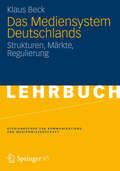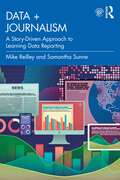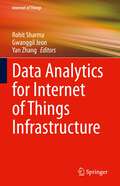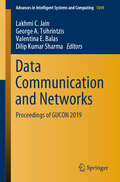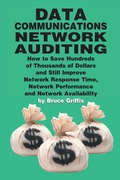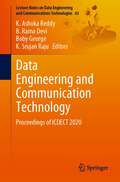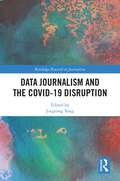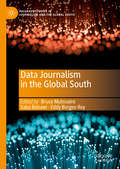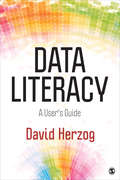- Table View
- List View
Das Best Situation Management Modell: Die Performanceorientierte Alternative zur BATNA (essentials)
by Hermann RockIn diesem Essential stellt Hermann Rock zunächst das in Harvard entwickelte und in der Praxis weithin verbreitete BATNA-Modell (Best Alternative To Negotiated Agreement) vor. Eine eingehende kritische Prüfung macht rasch die Schwachpunkte dieses Modells deutlich. Als Alternative präsentiert der Autor anschließend das Best Situation Management Modell (kurz BSM-Modell). Dabei wird deutlich, wie das BSM-Modell die performancebezogenen Mängel des BATNA-Modells kompensiert. Ziel der 7 Regeln des BSM-Modells ist ausschließlich die Optimierung Ihrer Verhandlungs-Performance. Das BSM-Modell beruht wissenschaftlich auf den Erkenntnissen jahrzehntelanger Verhandlungsforschung, die von den Professoren Neale/Lys in ihrem Werk Getting (more of) what you want) erklärt werden.
Das Bild in der Metapher: Bilder des Erfolgs – Bilder des Scheiterns
by Matthias JungeBilder und bildliche Vorstellungen bestimmen von der frühesten Kommunikation an unseren Zugang zur Welt. Das Ziel des Bandes ist eine umfassende Aufklärung der Prägung unserer Welt durch die verwendeten Bilder entlang ausgewählter Beispiele alltäglicher Bildlichkeit.
Das Experiment in der Kommunikations- und Medienwissenschaft: Grundlagen, Durchführung und Auswertung experimenteller Forschung (Studienbücher zur Kommunikations- und Medienwissenschaft)
by Thomas Koch Christina Peter Philipp MüllerDas Lehrbuch bietet einen umfassenden Überblick über das sozialwissenschaftliche Experiment. Es stellt Grundlagen und zentrale Begriffe vor und dient als praktischer Leitfaden, um Experimente durchzuführen. Mit zahlreichen Beispielen aus der Kommunikationswissenschaft liefert dieses Buch eine umfassende Hilfestellung für Methodenkurse und empirische Forschungsprojekte, die sich der experimentellen Forschung widmen.
Das Kommunikationskonzept: Einführung in die Entwicklung von Kommunikationskonzepten – In zehn Schritten zum Erfolg (essentials)
by Christoph BlankDieses essential bietet komprimiertes Wissen für alle, die Kommunikationskonzepte entwickeln, bewerten und umsetzen möchten. Dies ist weder Hexenwerk, noch nur etwas für kreative Köpfe. Der Prozess ist weitgehend standardisiert und folgt einer festen Struktur. Die in diesem Buch vorgestellte Vorgehensweise deckt in zehn Schritten alle entscheidenden analytischen, strategischen und operativen Aspekte ab, die kompakt und auf den Punkt beschrieben werden – mit dem Ziel eines umsetzungstauglichen Konzeptes für die Praxis. Hinweise zu weiterführender Literatur und nützlichen Tools bieten die Möglichkeit der Wissensvertiefung.
Das Mediensystem Deutschlands: Strukturen, Märkte, Regulierung (Studienbücher Zur Kommunikations- Und Medienwissenschaft Ser.)
by Klaus BeckDiese Einführung bietet eine historisch fundierte (ab 1945) systematische Darstellung der Grundstrukturen des bundesdeutschen Mediensystems und seiner kommunikationspolitischen Genese, insbesondere der ökonomischen, rechtlichen und technischen Grundlagen und Funktionsweisen der Medien der öffentlichen Kommunikation Printmedien, Rundfunk, Film, Online-Medien) sowie der medien-übergreifenden Strukturen/ Rahmenbedingungen (Nachrichten-, PR- und Werbeagenturen) sowie TK-Dienstleister. Darüber hinaus werden komparatistische Bezüge zu den Mediensystemen Österreichs und der Schweiz sowie Basisinformationen zu diesen beiden Mediensystemen hergestellt.
Das Mediensystem Deutschlands: Strukturen, Märkte, Regulierung (Studienbücher zur Kommunikations- und Medienwissenschaft)
by Klaus BeckDiese Einführung bietet eine historisch fundierte (ab 1945) systematische Darstellung der Grundstrukturen des bundesdeutschen Mediensystems und seiner kommunikationspolitischen Genese, insbesondere der ökonomischen, rechtlichen und technischen Grundlagen und Funktionsweisen der Medien der öffentlichen Kommunikation Printmedien, Rundfunk, Film, Online-Medien) sowie der medien-übergreifenden Strukturen/ Rahmenbedingungen (Nachrichten-, PR- und Werbeagenturen) sowie TK-Dienstleister. Darüber hinaus werden komparatistische Bezüge zu den Mediensystemen Österreichs und der Schweiz sowie Basisinformationen zu diesen beiden Mediensystemen hergestellt.
Das Nachrichtenverständnis junger Menschen: Definitionen und Erwartungen im Kontext aktueller journalistischer Information
by Markus WolsifferObwohl relativ viel über ihre Mediennutzung bekannt ist, weiß die Forschung erstaunlich wenig darüber, welche Erwartungen junge Menschen an journalistische Nachrichten richten. Ihre Perspektive wurde in Wissenschaft und Praxis lange vernachlässigt. Markus Wolsiffer setzt sich in diesem Band mit diesen Fragen auseinander und legt dar, weshalb die Erforschung des Nachrichtenverständnisses für eine Gesellschaft wichtig ist. Digitalisierung, wachsende Angebotsdifferenzierung und veränderte Nutzungsweisen führen zu Verwerfungen in der Medienwelt. Mittlerweile haben viele traditionelle Medienhäuser große Probleme, junge Menschen überhaupt noch zu erreichen. Jenseits ökonomischer Kalküle stellen sich damit auch normativ-demokratietheoretische Fragen: Was passiert mit einer Gesellschaft, wenn Nachrichten an Bedeutung verlieren und nichtjournalistische Plattformen zur bevorzugten Informationsquelle werden? Mit einer Kombination aus quantitativer und qualitativer Forschung liefert Markus Wolsiffer wichtige empirisch-analytische Grundlagen. Zugleich vermitteln seine Ergebnisse auch praktische Hinweise für Medienmacher und die Branche insgesamt.
Das Unternehmensprotokoll als nonverbales Instrument der Unternehmenskommunikation: Ein Mittel zur Stärkung der Corporate Identity (BestMasters)
by Rolando Martin Ortega PadillaIn diesem Buch wird das Unternehmensprotokoll als Bestandteil der Corporate Communication zur Stärkung der Corporate Identity untersucht. Dabei wird das Protokoll als nonverbales Instrument betrachtet, das durch qualitative Forschung, insbesondere Experteninterviews und Inhaltsanalyse, untersucht wurde. Die Ergebnisse zeigen, dass das Unternehmensprotokoll auf Ordnungs- und Hierarchieprinzipien basiert und den Umgang zwischen Unternehmensleitung und Schlüsselstakeholdern regelt, wodurch es ein positives Corporate Image fördert. Das Unternehmensprotokoll erweist sich somit als strategisches und operatives Mittel zur Außendarstellung, welches zur Festigung von Beziehungen beiträgt. Es schafft Rahmenbedingungen, die den Kommunikationsprozess beeinflussen und dabei helfen, die Unternehmensziele sichtbar zu machen. Besonders im Bereich der nonverbalen Kommunikation zeigt sich seine Fähigkeit, durch Raum und Zeit die interpersonale Kommunikation auf der höchsten Beziehungs-, Verhandlungs- und Repräsentationsebene zu prägen.
Das Verkaufsnavi für Medienberater: Der Fahrplan zu mehr Umsatz im Verkauf von Werbemitteln
by Ricky McKennaDieses Buch zeigt Medienverkäufern anhand einer strukturierten Schritt-für-Schritt-Anleitung den optimalen Verkaufsprozess auf: Mittels eines Verkaufsnavigators begleitet es Verkäufer aus dem Medienbusiness durch unterschiedliche Straßen und führt sie vom Start – der Suche nach geeigneten Kundenpotenzialen – zum Ziel: dem Verkaufsabschluss.Der Autor zeigt alle Baustellen und Umleitungen wie zum Beispiel Einwände oder taktische Preisverhandlungen auf, aber auch Abkürzungen, wie das Erkennen von frühzeitigen Kaufsignalen. Denn der Verkaufsprozess folgt immer einer klaren Struktur, und diese zu kennen, die jeweils passenden Techniken zu üben und immer wieder anzuwenden, kann zu spürbar mehr Umsatz führen.Ein kompaktes und unkompliziert lesbares Buch, gespickt mit persönlichen Erfahrungsberichten von Verkaufs- und Medienprofi Ricky McKenna, mit dessen Tipps Sie hochgesteckte Umsatzziele auch in wirtschaftlich schwierigen Zeiten erreichen.
Das globale Netz: Wirkungsweise und Grenzen der Datenübertragung im globalen Netz (essentials)
by Volkmar BrücknerVolkmar Brückner gibt einen Überblick über die Datenübertragung im Festnetz, durch Mobilfunk oder Satelliten sowie über globale mobile und optische Netze. Grenzen und Fehlerquellen für das Festnetz und die Übertragung bei der mobilen Kommunikation sowie Problemfelder in Technik und Ökologie werden angesprochen.
Das persönliche Gespräch: Großspender und Unternehmer erfolgreich ansprechen
by Andreas SchiemenzGroßspenden und Unternehmensspenden stellen einen der wichtigsten Erfolgsfaktoren im Fundraising dar und erfordern bei der Akquise besondere Herangehensweisen. Nur mit einer gezielten und persönlichen Ansprache lassen sich Großspender und Unternehmer als Unterstützer gewinnen. Schritt für Schritt erläutert Andreas Schiemenz - selbst mit langjähriger Erfahrung im Bereich des Fundraising für Großspender und Unternehmen in verschiedenen Non-Profit-Organisationen - wie Sie die richtigen Ansprechpartner finden und auswählen, eine individuelle Kommunikationsstrategie entwickeln, Gespräche mit potenziellen Spendern effizient nachbereiten und wie Sie Geber zu langfristigen Spendern machen. Dabei werden sowohl die strukturellen Prozesse bei der Tätigkeit von Spendenorganisationen beleuchtet als auch die praktische Umsetzung anhand zahlreicher Praxisbeispiele vorgestellt. ,,Fundraising macht Menschen glücklich" - die Geber, die Spendensammler und die Menschen, denen mit den finanzierten Projekten geholfen werden kann.
Das persönliche Gespräch: Großspender und Unternehmer erfolgreich ansprechen
by Andreas SchiemenzGroßspenden und Unternehmensspenden stellen einen der wichtigsten Erfolgsfaktoren im Fundraising dar und erfordern bei der Akquise besondere Herangehensweisen. Nur mit einer gezielten und persönlichen Ansprache lassen sich Großspender und Unternehmer als Unterstützer gewinnen. Schritt für Schritt erläutert Andreas Schiemenz – selbst mit langjähriger Erfahrung im Bereich des Fundraising für Großspender und Unternehmen in verschiedenen Non-Profit-Organisationen – wie Sie die richtigen Ansprechpartner finden und auswählen, eine individuelle Kommunikationsstrategie entwickeln, Gespräche mit potenziellen Spendern effizient nachbereiten und wie Sie Geber zu langfristigen Spendern machen. Dabei werden sowohl die strukturellen Prozesse bei der Tätigkeit von Spendenorganisationen beleuchtet als auch die praktische Umsetzung anhand zahlreicher Praxisbeispiele vorgestellt. „Fundraising macht Menschen glücklich“ – die Geber, die Spendensammler und die Menschen, denen mit den finanzierten Projekten geholfen werden kann.Die zweite Auflage wurde aktualisiert, um neue Gesprächsbeispiele und ein weiteres Kapitel ergänzt.
Das vergessene Subjekt: Subjektkonstitutionen in mediatisierten Alltagswelten (Medien • Kultur • Kommunikation)
by Jeffrey Wimmer Friedrich Krotz Rainer Winter Peter GentzelDer Band liefert eine kritische Bestandsaufnahme bestehender Subjektkonzeptionen der kommunikationswissenschaftlichen Forschung. Zudem werden Konzepte entwickelt um Subjektivität im Kontext aktueller theoretischer Debatten (u.a. Mediensoziologie, Cultural Studies, Psychoanalyse, Praxistheorie, Science and Technology Studies) sowie sozialer, kultureller und technischer Entwicklungen (u.a. Digitalisierung, Mediatisierung, Mobilität und Vernetzung) analysieren zu können. Da Subjektkonzeptionen für jegliche Kommunikations- und Medienanalysen von zentraler Bedeutung sind, schließt der Band eine zentrale Leerstelle der Kommunikations- und Medienwissenschaft.
Data + Journalism: A Story-Driven Approach to Learning Data Reporting
by Mike Reilley Samantha SunneTaking a hands-on and holistic approach to data, Data + Journalism provides a complete guide to reporting data-driven stories. This book offers insights into data journalism from a global perspective, including datasets and interviews with data journalists from countries around the world. Emphasized by examples drawn from frequently updated sets of open data posted by authoritative sources like the FBI, Eurostat and the US Census Bureau, the authors take a deep dive into data journalism’s "heavy lifting" – searching for, scraping and cleaning data. Combined with exercises, video training supplements and lists of tools and resources at the end of each chapter, readers will learn not just how to crunch numbers but also how to put a human face to data, resulting in compelling, story-driven news stories based on solid analysis. Written by two experienced journalists and data journalism teachers, Data + Journalism is essential reading for students, instructors and early career professionals seeking a comprehensive introduction to data journalism skills.
Data Analysis and Optimization for Engineering and Computing Problems: Proceedings of the 3rd EAI International Conference on Computer Science and Engineering and Health Services (EAI/Springer Innovations in Communication and Computing)
by Pandian Vasant Igor Litvinchev Jose Antonio Marmolejo-Saucedo Roman Rodriguez-Aguilar Felix Martinez-RiosThis book presents the proceedings of The EAI International Conference on Computer Science: Applications in Engineering and Health Services (COMPSE 2019). The conference highlighted the latest research innovations and applications of algorithms designed for optimization applications within the fields of Science, Computer Science, Engineering, Information Technology, Management, Finance and Economics and Health Systems. Focusing on a variety of methods and systems as well as practical examples, this conference is a significant resource for post graduate-level students, decision makers, and researchers in both public and private sectors who are seeking research-based methods for modelling uncertain and unpredictable real-world problems.
Data Analytics for Internet of Things Infrastructure (Internet of Things)
by Rohit Sharma Yan Zhang Gwanggil JeonThis book provides techniques for the deployment of semantic technologies in data analysis along with the latest applications across the field such as Internet of Things (IoT). The authors focus on the use of the IoT and big data in business intelligence, data management, Hadoop, machine learning, cloud, smart cities, etc. They discuss how the generation of big data by IoT has ruptured the existing data processing capacity of IoT and recommends the adoption of data analytics to strengthen solutions. The book addresses the challenges in designing the web based IoT system, provides a comparative analysis of different advanced approaches in industries, and contains an analysis of databases to provide expert systems. The book aims to bring together leading academic scientists, researchers, and research scholars to exchange and share their experiences and research results on all aspects of IoT and big data analytics.
Data Classification and Incremental Clustering in Data Mining and Machine Learning (EAI/Springer Innovations in Communication and Computing)
by Sk Hafizul Islam Debabrata Samanta Sanjay ChakrabortyThis book is a comprehensive, hands-on guide to the basics of data mining and machine learning with a special emphasis on supervised and unsupervised learning methods. The book lays stress on the new ways of thinking needed to master in machine learning based on the Python, R, and Java programming platforms. This book first provides an understanding of data mining, machine learning and their applications, giving special attention to classification and clustering techniques. The authors offer a discussion on data mining and machine learning techniques with case studies and examples. The book also describes the hands-on coding examples of some well-known supervised and unsupervised learning techniques using three different and popular coding platforms: R, Python, and Java. This book explains some of the most popular classification techniques (K-NN, Naïve Bayes, Decision tree, Random forest, Support vector machine etc,) along with the basic description of artificial neural network and deep neural network. The book is useful for professionals, students studying data mining and machine learning, and researchers in supervised and unsupervised learning techniques.
Data Communication and Networks: Proceedings of GUCON 2019 (Advances in Intelligent Systems and Computing #1049)
by Lakhmi C. Jain George A. Tsihrintzis Valentina E. Balas Dilip Kumar SharmaThis book gathers selected high-quality papers presented at the International Conference on Computing, Power and Communication Technologies 2019 (GUCON 2019), organized by Galgotias University, India, in September 2019. The content is divided into three sections – data mining and big data analysis, communication technologies, and cloud computing and computer networks. In-depth discussions of various issues within these broad areas provide an intriguing and insightful reference guide for researchers, engineers and students alike.
Data Communications Network Auditing
by Bruce GriffisThis book contains product specific information based on Cisco router command line interface, and IBM's Net view. It is designed to help us understand the "parts and pieces" of communications and determine how components fit together, and what they look like on your bill.
Data Engineering and Communication Technology: Proceedings of 3rd ICDECT-2K19 (Advances in Intelligent Systems and Computing #1079)
by Roman Senkerik K. Srujan Raju Satya Prasad Lanka V. RajagopalThis book includes selected papers presented at the 3rd International Conference on Data Engineering and Communication Technology (ICDECT-2K19), held at Stanley College of Engineering and Technology for Women, Hyderabad, from 15 to 16 March 2019. It features advanced, multidisciplinary research towards the design of smart computing, information systems, and electronic systems. It also focuses on various innovation paradigms in system knowledge, intelligence, and sustainability which can be applied to provide viable solutions to diverse problems related to society, the environment, and industry.
Data Engineering and Communication Technology: Proceedings of ICDECT 2020 (Lecture Notes on Data Engineering and Communications Technologies #63)
by K. Srujan Raju Boby George K. Ashoka Reddy B. Rama DeviThis book includes selected papers presented at the 4th International Conference on Data Engineering and Communication Technology (ICDECT 2020), held at Kakatiya Institute of Technology & Science, Warangal, India, during 25–26 September 2020. It features advanced, multidisciplinary research towards the design of smart computing, information systems and electronic systems. It also focuses on various innovation paradigms in system knowledge, intelligence and sustainability which can be applied to provide viable solutions to diverse problems related to society, the environment and industry.
Data Journalism and the COVID-19 Disruption (Routledge Research in Journalism)
by Jingrong TongData Journalism and the COVID‑19 Disruption offers an international, multidisciplinary account of how and to what extent the COVID‑19 pandemic has been a blessing for data journalism.Bringing together insights into current developments in data journalism during (and since the onset of) the COVID‑19 pandemic from world‑leading data journalism practitioners and academics, this book draws on case studies and examples from different countries to critically reflect on emerging data journalism practices during the pandemic and their sustainability and implications for journalism and newsroom work in the post‑pandemic era. The chapters document changes in the practice and integration of data journalism into newsrooms and the 24/7 news cycle after the unexpected onset of the pandemic and explore how newsrooms and journalists are coping with the sudden and immense demand for data journalism and related challenges. This book also scrutinises the implications for understanding the roles played by newsroom structure and operation, the uncertain nature of data, and the relationship between journalism and other social entities such as audiences and the state in journalism’s development through times of crisis.Offering a timely contribution to the discussions on how data journalism evolved during a time of crisis, this volume will appeal to scholars and students of data journalism, journalism practice, media and communication studies, and media industry studies.
Data Journalism in the Global South (Palgrave Studies in Journalism and the Global South)
by Saba Bebawi Bruce Mutsvairo Eddy Borges-ReyThis volume seeks to analyse the emerging wave of data journalism in the Global South. It does so by examining trends, developments and opportunities for data journalism in the aforementioned contexts. Whilst studies in this specific form of journalism are increasing in numbers and significance, there remains a dearth of literature on data journalism in less developed regions of the world. By demonstrating an interest in data journalism across countries including Chile, Argentina, the Philippines, South Africa and Iran, among others, this volume contributes to multifaceted transnational debates on journalism, and is a crucial reference text for anyone interested in data journalism in the ‘developing’ world. Drawing on a range of voices from different fields and nations, sharing empirical and theoretical experiences, the volume aims to initiate a global dialogue among journalism practitioners, researchers and students.
Data Literacy: A User′s Guide
by David L. HerzogA practical, skill-based introduction to data analysis and literacy We are swimming in a world of data, and this handy guide will keep you afloat while you learn to make sense of it all. In Data Literacy: A User′s Guide, David Herzog, a journalist with a decade of experience using data analysis to transform information into captivating storytelling, introduces students and professionals to the fundamentals of data literacy, a key skill in today’s world. Assuming the reader has no advanced knowledge of data analysis or statistics, this book shows how to create insight from publicly-available data through exercises using simple Excel functions. Extensively illustrated, step-by-step instructions within a concise, yet comprehensive, reference will help readers identify, obtain, evaluate, clean, analyze and visualize data. A concluding chapter introduces more sophisticated data analysis methods and tools including database managers such as Microsoft Access and MySQL and standalone statistical programs such as SPSS, SAS and R.






